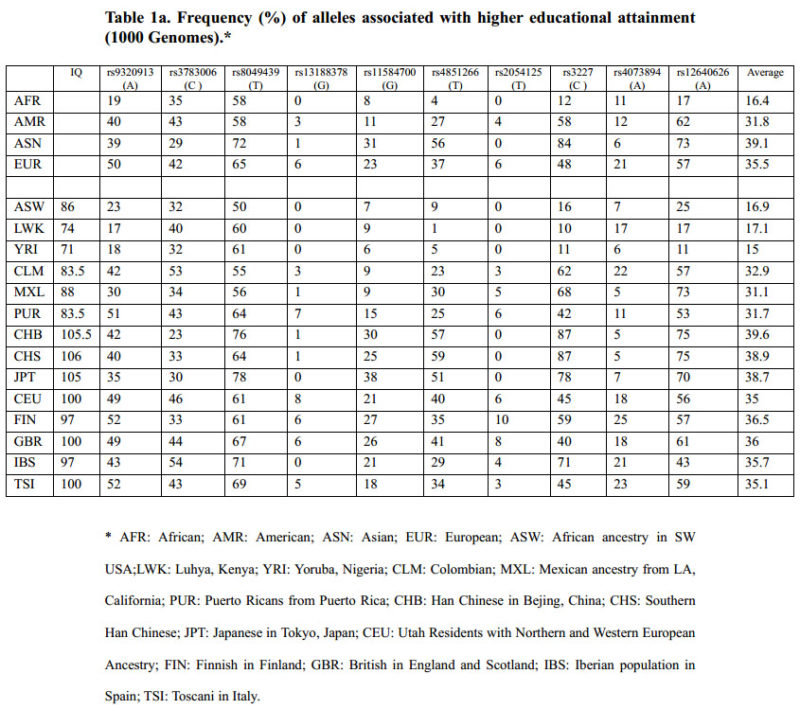Factor Analysis of Population Allele Frequencies as a Simple, Novel Method of Detecting Signals of Recent Polygenic Selection: The Example of Educational Attainment and IQ
Davide Piffer, Interdisciplinary Bio Central, November 27, 2013
Synopsis
Weak widespread (polygenic) selection is a mechanism that acts on multiple SNPs simultaneously. The aim of this paper is to suggest a methodology to detect signals of polygenic selection using educational attainment as an example. Educational attainment is a polygenic phenotype, influenced by many genetic variants with small effects. Frequencies of 10 SNPs found to be associated with educational attainment in a recent genome-wide association study were obtained from HapMap, 1000 Genomes and ALFRED. Factor analysis showed that they are strongly statistically associated at the population level, and the resulting factor score was highly related to average population IQ (r=0.90). Moreover, allele frequencies were positively correlated with aggregate measures of educational attainment in the population, average IQ, and with two intelligence increasing alleles that had been identified in different studies. This paper provides a simple method for detecting signals of polygenic selection on genes with overlapping phenotypes but located on different chromosomes. The method is therefore different from traditional estimations of linkage disequilibrium. This method can also be used as a tool in gene discovery, potentially decreasing the number of SNPs that are included in a genome-wide association study, reducing the multiple-testing problem and required sample sizes and consequently, financial costs.
Results
Tables 1a and 1b report frequencies of alleles associated with higher educational attainment (“beneficial” for short) for the 14 populations of 1000 Genomes and the 11 HapMap populations (list-wise deletion of missing data). Frequencies of the 10 SNPs were averaged for each population, so as to obtain a single reliable value (or polygenic score) that also avoided the problem of multiple comparisons. The polygenic score is reported in the last column. The results are similar across the HapMap and 1000 Genomes data sets: East Asian populations (Japanese, Chinese) have the highest average frequency of “beneficial” alleles (39%), followed by Europeans (35.5%) and sub-Saharan Africans (16.4%).
{snip}
Discussion
The national ranking for scores on standardized tests of educational attainment closely mirrors the gradient observed in frequencies of genes associated with this construct. East Asians have the highest frequencies of alleles beneficial to educational attainment (39%) and consistently outperform other racial groups both within the US and around the world, in terms of educational variables such as completion of college degree or results on standardized tests of scholastic achievement. Europeans have slightly lower frequencies of educational attainment alleles (35.5%) and perform slightly worse in terms of educational attainment, compared to East Asians. On the other hand, Africans seem to be disadvantaged both with regards to their level of educational attainment in the US and around the world. Indeed, Africans have the lowest frequencies of alleles associated with educational attainment (16%).
{snip}
[Editor’s Note: The full study is available at the original article link below.]
















